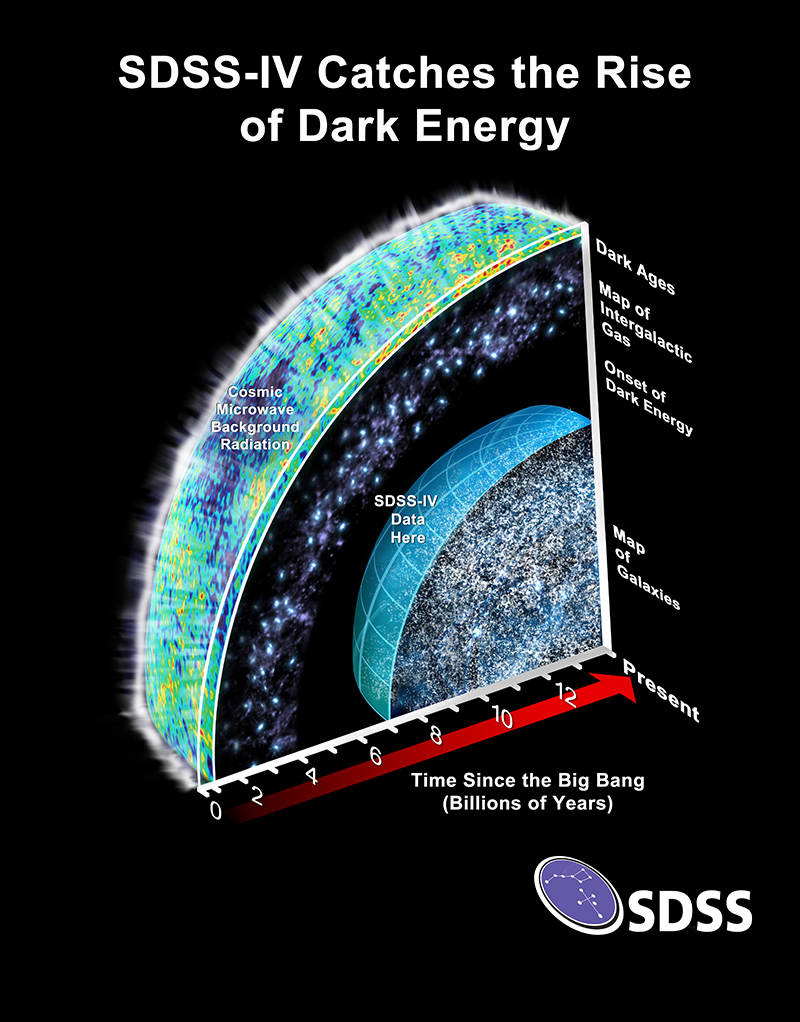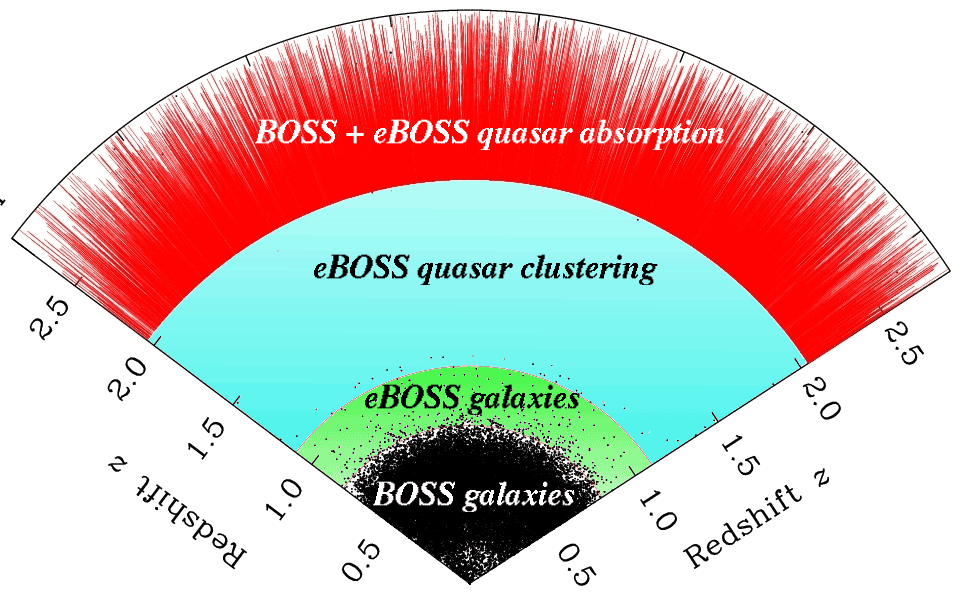eBOSS

When combined with previous phases of SDSS, eBOSS precisely measures the expansion history of the Universe throughout eighty percent of cosmic history, back to when the Universe was less than three billion years old. These measurements improve constraints on the nature of "Dark Energy", the observed phenomenon that the expansion of the Universe is currently accelerating. Dark Energy remains one of the most mysterious experimental results in modern physics.
eBOSS concentrates on the observation of galaxies and quasars, in a range of distances (redshifts) currently left completely unexplored by other three-dimensional maps of large-scale structure in the Universe. In filling this gap, eBOSS creates the largest volume survey of the Universe to date. The figure to the right shows the region newly mapped by the eBOSS project. This region corresponds to the epoch when the Universe was transitioning from deceleration due to the effects of gravity, to the current epoch of acceleration.
The combination of eBOSS with the SPIDERS, X-ray selected quasar sample and the TDSS, variability selected AGN sample, creates a unique window to the full population of quasars at all epochs to redshift z = 3.
Results from eBOSS
- The final measurements, a series of complementary studies, and the cosmological interpretation were made public on 20 July 2020, with an SDSS press release describing those efforts. Included in this release is a visualization the data, a video on the legacy of SDSS, and a video describing the eBOSS program.
- Details from the final BAO and RSD measurements from all SDSS surveys, including the target selection algorithms, catalogs, and measurements from all SDSS surveys, are provided for those who want to use these results in independent analyses.
- The cosmological analysis from BAO, RSD, and other probes provides 1% precision constraints on the cosmological model, with major advances enabled by the SDSS legacy surveys.
- The full list of publications from eBOSS includes studies of cosmology, galaxy science, and quasar physics.
- The likelihoods, covariance matrices, and cosmoMC chains with the SDSS data can be found in the SDSS SVN depository here.
The Full Map from SDSS, BOSS, and eBOSS Clustering Surveys
Credits: EPFL and the SDSS Collaboration
Key Science Questions
- How does the transition from deceleration to acceleration occur? Is it consistent with existing theories of dark energy?
- How does structure grow during this epoch? Are there signs of violations of the general relativistic theory of gravity, which could be related to the acceleration?
- Can we detect anomalies in the very largest scale clustering that could tell us about the earliest moments in the Universe's history?
- Can we detect the effects of cosmic neutrinos, and thus pin down the neutrino mass scale?
- What is the evolution of bright quasars of all luminosities out to redshift z = 3?
eBOSS Technical Details
- Dark-time observations
- July 2014 – March 2019
- 1000 fibers per 7-square-degree plate
- Wavelength: 360-1000 nm, resolution R~2000
- 300,000 luminous red galaxies over 6,000 square degrees, 0.6 < z < 1.0
- 175,000 emission line galaxies over 1,000 square degrees, 0.6 < z < 1.1
- 500,000 quasars over 6,000 square degrees, 0.8 < z < 3.5
- 1–2% distance measurements from baryon acoustic oscillations between 0.6 < z < 2.5
- Principal Investigator
- Kyle Dawson (University of Utah)
- Deputy PI
- Jean-Paul Kneib (EPFL)
- Survey Scientist
- Will Percival (University of Waterloo)
- Catalog Scientist
- Ashley Ross (The Ohio State University)
- Targeting Coordinator
- Jeremy Tinker (New York University)
- Tiling Coordinator
- Hee-Jong Seo (Ohio University)
- Lead Data Scientist
- Julian Bautista (University of Portsmouth)
eBOSS Data Management Plan
- specific to eBOSS as required by the Department of Energy
eBOSS Sub-programs

eBOSS also includes two subprograms to follow up on other types of objects: the Time-Domain Spectroscopic Survey (TDSS) for variable objects, and the SPectroscopic IDentification of ERosita Sources (SPIDERS) for X-ray sources.
TDSS
TDSS Team
- Principal Investigators
- Paul Green (SAO/CfA) and Scott Anderson (UW)
- Recent Targeting Coordinator
- Chelsea MacLeod (formerly SAO/CfA)
- Recent Data Coordinator
- John Ruan (formerly UW; recently McGill)
The Time-Domain Spectroscopic Survey (TDSS) selects photometrically variable targets (especially from Pan-STARRS 1 and archival SDSS imaging) for spectroscopic follow-up. These targets include quasars and multiple classes of variable stars, some of which may reveal previously unidentified phenomena. By spectroscopically identifying the physical nature of 100,000 detected variables, TDSS will greatly enhance the power of these existing data sets to illuminate the physics of stars and quasars. Future photometric surveys (such as the Vera C. Rubin Observatory) will leverage TDSS observations to classify their detections more robustly.
TDSS additionally devotes a number of fibers to both "few-epoch spectroscopy" (FES) and to "repeat quasar spectroscopy" (RQS), and these both study optical spectroscopic variability. FES emphasizes multi-epoch observations of selected special subclasses known or suspected to reveal spectral variability, such as double-peaked emission line quasars, broad-absorption line quasars, and dwarf carbon stars; RQS emphasizes in a less subclass biased way the multi-epoch spectroscopy of quasars across a broad range of redshift and luminosity.
Further descriptions (and references) are available for the TDSS program and associated target selection approaches.
SPIDERS
SPIDERS Team
- Principal Investigators
- Andrea Merloni and Kirpal Nandra (MPE)
- AGN Survey Coordinator
- Antonis Georgakakis (MPE)
- Clusters Survey Coordinator
- Nicolas Clerc (IRAP)
- Targeting Coordinator
- Tom Dwelly (MPE)
- Data Coordinator
- Johan Comparat (MPE)
The main goal of the SPectroscopic IDentfication of ERosita Sources (SPIDERS) survey is to provide a complete and homogeneous optical spectroscopic followup of X-ray sources (both point-like and extended) detected by eROSITA in its first year of survey operation, to begin in Summer 2019. Before then, the SPIDERS Survey will be executed in steps, corresponding to different (increasing) levels of allocated fiber density, with the shallower early phase dedicated to the follow-up of the only existing wide area homogeneous X-ray surveys. In particular, we will target all the ROSAT All-Sky Survey (RASS) sources still missing spectroscopic follow-up within the full eBOSS footprint, as well as the hard X-ray AGN from the shallow XMM-Newton Slew Survey. Detailed description of the target selection and links to value-added catalogs are available in the SPIDERS program and target selection pages.
SPIDERS will follow-up clusters of galaxies selected by cross-correlating faint ROSAT sources with red-galaxy excess found in SDSS imaging in the range 0.1<z<0.6. These are the most massive and largest clusters in the X-ray sky, and represent a well-defined sample that can be used as a first stepping stone for cluster cosmology experiments via measurement of the growth of structure (with ~4,500 clusters, it will be by far the largest homogeneously X-ray selected sample with full spectroscopic followup). Once eROSITA data become available, we will be able to target additional ~1,500 fainter, smaller mass and higher redshift clusters. The better angular resolution of eROSITA over ROSAT, and the better energy resolution, implies we will be able to better characterize the X-ray/optical selection and provide competitive cosmological measurements of cosmic growth.
eBOSS/SPIDERS shall also obtain >30,000 spectra of ROSAT, XMM and eROSITA X-ray selected AGN, about 40% of which in common with eBOSS QSO program and the remaining unique SPIDERS AGN targets. This spectroscopic X-ray selected sample will be ~2.5 times larger than the total number of X-ray AGN with spectroscopic redshift currently known, and about a factor 10 larger than any existing coherent, contiguous, well-defined, X-ray survey.


